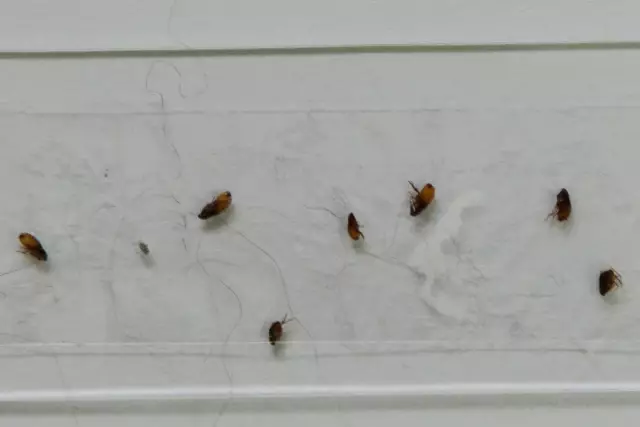- Author Curtis Blomfield [email protected].
- Public 2023-12-16 20:44.
- Last modified 2025-01-23 17:01.
Human fleas (Pulex irritans) are insects belonging to the Pulicidae family. They are small in size (from 1 mm to 5 mm), yellow-brown or almost black in color. Parasites have a body flattened on the sides, a small head with a piercing-sucking type of mouth apparatus. They have three pairs of limbs (the last one performs a jumping function), there are no wings.

Human fleas have adapted to life on the body of people, despite their insignificant hairline. They can feed not only on the blood of Homo sapiens, but also on dog, cat, horse, etc. The time of one sucking is from 1 to 20 minutes, and they take “food” twice a day. Under adverse conditions, these creatures can starve for a long time.
The human flea, the photo of which is shown here, can lay up to 8 eggs at a time. She lives for about a year, which means that the number of eggs laid by her in her entire life is about 500 pieces. The place of masonry is usually the gaps between the parquets, rugs, pet bedding.etc.
The larvae emerge from the eggs. They are legless and move like worms. They feed on organic matter. In their development, the larvae undergo three molts and pupate. The time spent in a cocoon is directly dependent on environmental conditions and can stretch up to two years. After emerging from the cocoon, young fleas will try to find food on a person or pet.
Being outside the object of food, human fleas usually move by jumping. They can jump on walls and interior items, but not higher than 1 m from the floor. Once on the skin of a living organism, they crawl from place to place in search of the best place to suck.

Human fleas pierce the skin and inject a special substance contained in their saliva, which prevents the victim's blood from clotting. This substance is allergenic to humans, so redness, swelling and severe itching and burning are felt at the site of the bite. Combing the affected area, you can re-infect it. With multiple bites, the general condition of a person worsens, and children react to this more sharply.
The ability to jump from one person to another and therefore carry an infection that enters directly into the blood is the greatest danger to people. Plague, tularemia, brucellosis, pseudotuberculosis, anthrax - this is an incomplete list of diseases transmitted by human fleas.
All things considered, the presence of fleas in the house must be taken seriously. Measures towithdrawing them must be taken without delay. It is difficult to get rid of them on your own, since an incorrectly calculated dosage of poison can develop immunity to the active substance in parasites. In this case, you will have to look for another drug and re-treat. Therefore, without consulting a specialist, it is better not to take any action.

Can move from one room to another and again return to the skin of a human flea. How to get rid of it once and for all? It will be necessary to process the entire infected area, including neighboring apartments. 3 days after treatment, all carpets, upholstered furniture will need to be vacuumed, removing all dead parasites, their eggs, as well as larvae.
As a preventive measure against fleas, it is necessary to inspect pets that can bring parasites on themselves. Tailed friends should be bathed with zoo shampoos, their bedding should be treated. You need to regularly use anti-flea collars, drops, sprays.
Fortunately, human fleas in our time - a rare phenomenon. But if you had to meet with them, then the fight is quite capable of winning.






